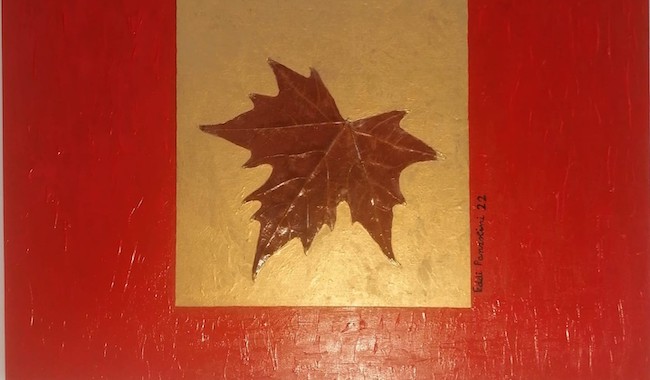Esistono percorsi di approfondimento della propria interiorità che vanno lasciati fuoriuscire in virtù della contrapposizione tra i lati opposti della personalità, e questo è tanto più vero quanto più ci si immerge nel mondo della creatività; gli artisti sono in grado di osservare le profondità del loro animo e poi lo manifestano quasi come se il dipingere fosse un atto liberatorio proprio per quella parte che diversamente non riuscirebba a raggiungere la consapevolezza e di conseguenza la libertà di esprimersi. Nel momento in cui ci si trova davanti a questo tipo di approccio pittorico l’inclinazione più comune è quella di perdersi nel mondo informale, poiché spesso quelle sensazioni o quelle necessità sotterranee non riuscirebbero a fuoriuscire attraverso una forma definita e affine al lato razionale che tenderebbe così a ricacciare indietro il mondo interiore. Il protagonista di oggi sceglie dunque uno stile informale per dare voce a quella parte di sé che ha bisogno di emergere per ribilanciare, attraverso la contemplazione e la calma, la sua personalità dinamica.
I primi anni del Ventesimo secolo hanno introdotto nell’arte una dimensione precedentemente sconosciuta in quanto gli insegnamenti accademici erano ancora legati a un’armonia estetica, a una perfetta riproduzione dell’osservato e al concetto che un dipinto o una scultura dovessero descrivere nella maniera più veritiera tutto ciò che lo sguardo poteva cogliere intorno a sé; nel nuovo concetto elaborato da un gruppo di artisti coraggiosi e in grado di andare contro i gusti e i parametri dei collezionisti dell’epoca, decisero invece di scegliere una sperimentazione che li stava conducendo a ripudiare tutte le scelte dei precedenti movimenti, non solo quelle del Realismo che aveva dominato gran parte dell’Ottocento ma anche degli stili più innovativi come l’Impressionismo e il Divisionismo che però rimanevano sempre legati alla realtà osservata. Con l’Astrattismo si verificò un distacco totale da qualsiasi riferimento conosciuto, per spingere l’arte verso il mondo dell’invisibile, di una perfezione plastica che prescindeva dall’oggettività e si spingeva verso una dimensione impensata fino a poco prima. Le innovazioni in questo senso partirono dall’Europa orientale, con Vassily Kandinsky e Kasimir Malevic, e dall’Europa nord-occidentale con il De Stijl di Piet Mondrian che costituirono la prima clamorosa rottura con il mondo dell’arte precedente; il loro intento era quello di sottolineare la pura bellezza del gesto plastico, senza che questo avesse alcun tipo di riferimento con l’emotività dell’esecutore dell’opera. Tuttavia con l’avanzare dei periodi storici, con il susseguirsi delle due guerre mondiali, e con l’esigenza dei creativi di recuperare la propria soggettività, gli astrattisti decisero di ammorbidire le linee guida e di permettere che le forme indefinite divenissero espressione del loro sentire. L’Espressionismo Astratto lasciò piena libertà interpretativa a ciascun esponente, purché le tele fossero prolungazione della loro interiorità; dunque le ambientazioni silenziose e suggestive di Mark Rothko si contrapponevano a quelle irruente e impulsive di Jackson Pollock, ma anche altri linguaggi artistici tesero verso l’irrealtà formale, come per esempio il Dadaismo di Hans Arp oppure la stilizzazione figurativa di Giulio Turcato e Carla Accardi, o infine l’Informale Materico di Alberto Burri e Antoni Tapìes, dove la materia diveniva enfatizzazione del sentire più profondo. Tutto era funzionale a lasciar emergere, più o meno consapevolmente quel mondo interiore che corrispondeva all’altro lato del sé. Lo stile artistico di Eddi Panzolini affonda le sue radici proprio nel concetto dell’Astrattismo per manifestare la sua identità nascosta, quella che ha bisogno di prendersi una pausa da se stesso, di sedersi e riflettere per poter accogliere la necessità di soffermarsi, anche se solo per il tempo dell’esecuzione pittorica, sul ritmo lento, sull’analisi della sensazione di fermo immagine di cui ha bisogno per potersi scoprire.
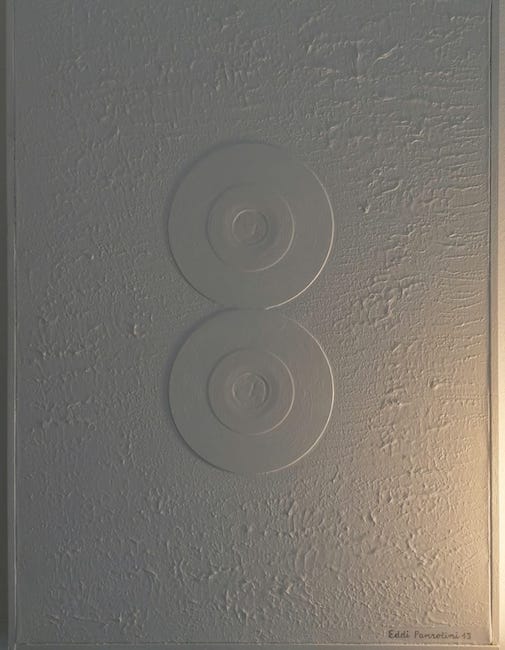
Formatosi come autodidatta e scegliendo di mantenere viva la sua passione artistica malgrado le scelte di vita e professionali che lo hanno condotto verso un’altra direzione, Eddi Panzolini sembra voler sperimentare le varie sfaccettature dell’Astrattismo, a volte più assoluto e minimalista, altre invece stilizzato ma ancora legato a forme conosciute, per approfondire e lasciar parlare ciascuno degli aspetti che lo contraddistinguono, vissuti però in questo caso con meditazione e approfondimento attraverso cui sceglie l’equilibrio perfetto tra orientamento cromatico e scena rappresentata.
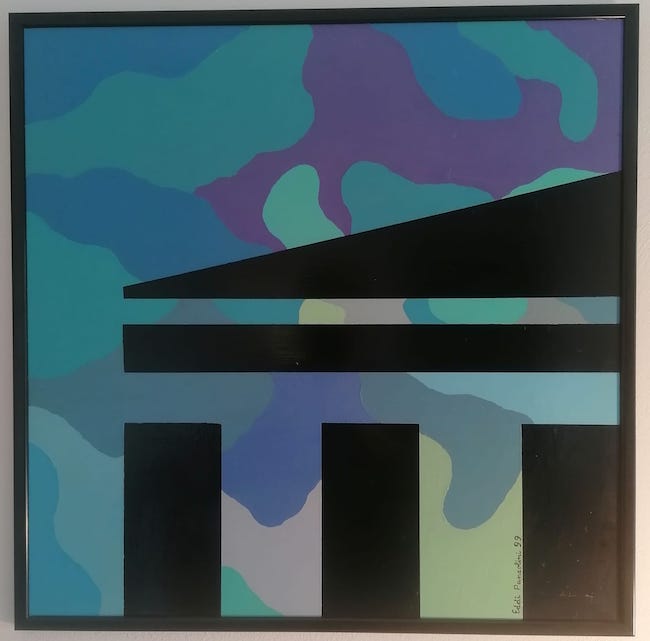
Si misura con temi universali, quelli legati alle eterne domande senza risposta che l’essere umano si pone da sempre, oppure con paesaggi intimisti, da lui reinterpretati alla luce di una tendenza alla sintesi che gli consente di lasciar emergere solo l’essenziale; o ancora racconta i simboli di ciò che per lui è importante, sempre minimizzandoli nella forma che diviene spesso unico elemento riconducibile alla realtà all’interno di una decontestualizzazione assoluta e indefinita.
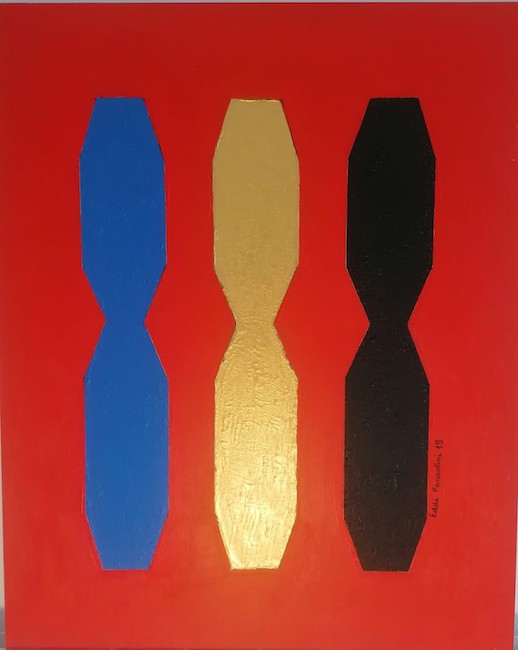
La foglia oro domina nella maggior parte delle tele di Eddi Panzolini, come se volesse sottolineare l’importanza della luce, della magnificenza riscontrabile in ogni singolo elemento se solo l’animo fosse capace di osservare l’ambiente circostante con positività e fiducia, della ricchezza che emerge da ogni istante vissuto; dal punto di vista cromatico invece le tonalità primarie come il rosso, il nero e l’azzurro, oltre all’immancabile oro, sono dominanti nelle opere più descrittive, mentre per quelle più concettuali le tonalità diventano chiare, tenui, sfumate, a sottolineare la morbidezza del possibilismo.
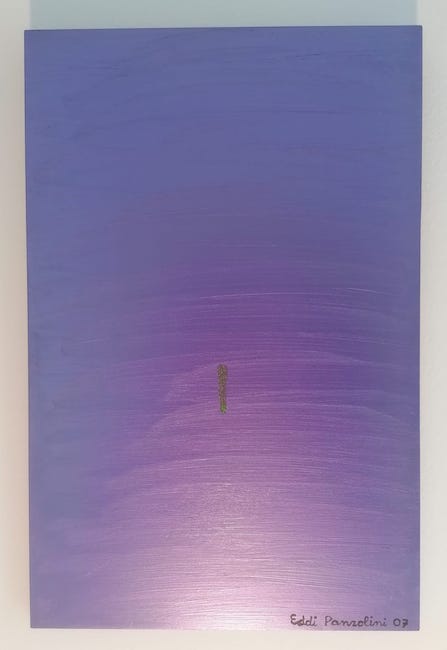
Il dipinto Tear, con i suoi colori delicati e soffici, evoca quella suggestione che poi induce lo sguardo a soffermarsi sulla lacrima al centro della tela, in qualche modo avvolta dal silenzio del motivo per il quale è caduta rappresentando un momento di sofferenza dell’individuo o più universalmente dell’umanità. I toni del lilla e del viola corrispondono ai colori dell’anima, quella che spesso si abbandona al pianto in un angolo nascosto dell’interiorità nella speranza di dimenticare presto la causa della sua origine; tuttavia Eddi Panzolini sembra invece sottolineare l’importanza dell’affrontare anche quel frangente di sconforto, perché è grazie a esso che sarà possibile rinascere a nuove emozioni. È questa la funzione di quel centro rosato che sembra avvolgere la lacrima come se fosse un morbido cuscino di protezione della sua delicatezza e al contempo la speranza che si propaga e si trasforma in una nuova consapevolezza.
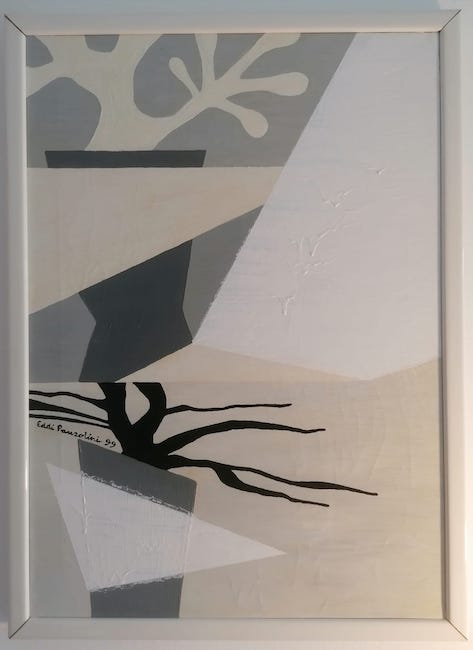
In Ombre invece l’artista si avvicina alle figure stilizzate che tanto avevano contraddistinto il tardo Matisse o Hans Arp, aggiungendo però non solo la sinuosità della linea curva bensì introducendo anche elementi geometrici che sembrano sottolineare, grazie all’utilizzo della gamma cromatica in scala di grigi, l’alternanza tra luce e ombra che appartiene di fatto alla vita, quel rivelarsi e nascondersi in cui Eddi Panzolini non lascia mai predominare la seconda utilizzando il nero solo e unicamente per sottolineare i rami dell’albero, simbolo metaforico delle radici, come se lo lasciasse alle spalle del suo cammino per non dimenticare il punto di partenza, ma poi tendendo verso la luminosità del presente e del futuro.
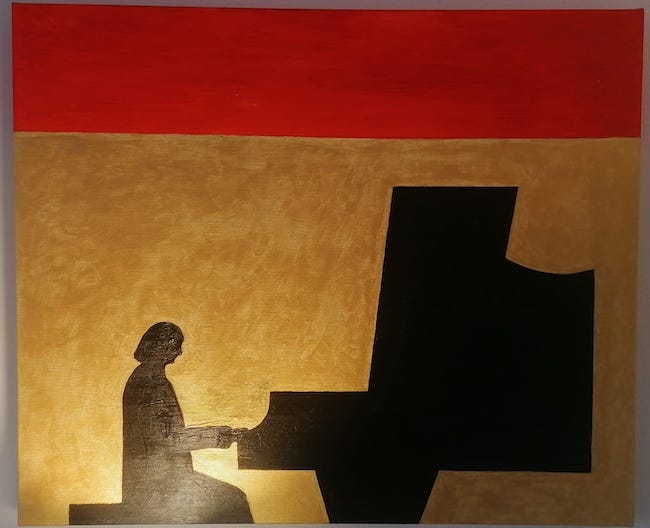
Nel dipinto Pianista invece l’artista non può fare a meno di rendere omaggio a un’altra sua grande passione, quella della musica, che da sempre accompagna la sua vita e che non può in alcun modo essere scissa dalla creatività artistica, quasi come se la prima fosse sottofondo indispensabile per sollecitare il processo di ascolto verso quell’interiorità troppo spesso lasciata in silenzio nella quotidianità, dove a emergere deve necessariamente essere il lato logico e razionale. Qui la stilizzazione è funzionale a infondere nell’osservatore il senso mistico della realtà osservata, rievocando le atmosfere del film La leggenda del pianista sull’oceano infondendo però all’immagine la preziosità della foglia oro e attraverso cui Panzolini sottolinea la rilevanza che le note musicali hanno, e continuano ad avere, nella sua vita; la figura del pianista sembra essere messa in controluce mentre sullo sfondo l’artista appone la foglia oro, che rappresenta la piacevolezza del lasciarsi andare alla melodia, e il rosso che sottolinea invece la forza e la determinazione del coltivare la propria passione solo per il piacere di farlo, esattamente come è successo a lui per tutta la sua vita.

Eddi Panzolini partecipa regolarmente a mostre collettive in Umbria, nelle Marche e in Veneto, e a concorsi d’arte dove riceve non solo consensi da parte del pubblico ma anche premi, tra i più rilevanti quelli riconosciutigli per tre anni consecutivi al concorso nazionale 50 & Più.
EDDI PANZOLINI-CONTATTI
Email: panzolinieddi@gmail.com
Facebook: www.facebook.com/eddi.panzolini
Instagram: www.instagram.com/eddi.panzolini/
The calm Abstract Expressionism by Eddi Panzolini, between the tendency towards figurative stylisation and the abstract awareness of having to accept emotions
There are paths of deepening one’s interiority that must be let out by virtue of the contraposition between the opposite sides of the personality, and this is all the more true the more one plunges into the world of creativity; artists are able to observe the depths of their soul and then manifest it almost as if painting were a liberating act for that very part that otherwise would not be able to reach awareness and consequently the freedom to express itself. When confronted with this type of pictorial approach, the most common inclination is to lose oneself in the informal world, as often those feelings or those subterranean needs would not be able to escape through a defined form akin to the rational side, which would thus tend to drive back the inner world. Today’s protagonist therefore chooses an informal style to give voice to that part of himself that needs to emerge to rebalance, through contemplation and calm, his dynamic personality.
The early years of the 20th century introduced a previously unknown dimension into art, as academic teachings were still tied to aesthetic harmony, to a perfect reproduction of the observed, and to the concept that a painting or sculpture should describe as truthfully as possible all that the eye could grasp around it; in the new concept developed by a group of courageous artists who were able to go against the tastes and parameters of the collectors of the time, they decided instead to choose an experimentation that was leading them to repudiate all the choices of the previous movements, not only those of Realism that had dominated much of the 19th century but also the more innovative styles such as Impressionism and Divisionism, which however always remained linked to the observed reality. With Abstractionism there was a total detachment from any known reference, to push art towards the world of the invisible, of a plastic perfection that transcended objectivity and moved towards a dimension unthought of until recently.
The innovations in this sense started in Eastern Europe, with Vassily Kandinsky and Kasimir Malevic, and in North-Western Europe with Piet Mondrian‘s De Stijl, which constituted the first resounding break with the previous art world; their intention was to emphasise the pure beauty of the plastic gesture, without it having any kind of reference to the emotionality of the author of the artwork. However, as the historical periods progressed, with the succession of the two world wars, and with the need for creatives to recover their subjectivity, the abstractionists decided to soften the guidelines and allow the undefined forms to become an expression of their feeling. Abstract Expressionism left full interpretative freedom to each exponent, as long as the canvases were an extension of their interiority; thus Mark Rothko‘s silent and evocative settings contrasted with Jackson Pollock‘s impetuous and impulsive ones, but other artistic languages also tended towards formal unreality, such as the Dadaism of Hans Arp or the figurative stylisation of Giulio Turcato and Carla Accardi, or finally the Materic Informalism of Alberto Burri and Antoni Tapìes, where matter became an emphasis of the deepest feeling. Everything was functional in allowing to emerge, more or less consciously, that inner world that corresponded to the other side of the self.
Eddi Panzolini‘s artistic style is rooted precisely in the concept of Abstractionism to manifest his hidden identity, the one that needs to take a break from himself, to sit and reflect in order to welcome the need to pause, even if only for the time of the pictorial execution, on the slow rhythm, on the analysis of the still-image sensation that he needs in order to discover himself. Trained as a self-taught artist and choosing to keep his artistic passion alive despite life and professional choices that have led him in another direction, Eddi Panzolini seems to want to experiment with the various facets of Abstractionism, at times more absolute and minimalist, at others stylised but still linked to known forms, in order to deepen and let each of the aspects that distinguish it speak for itself, experienced in this case however with meditation and in-depth analysis through which he chooses the perfect balance between chromatic orientation and the scene represented. He measures himself against universal themes, those linked to the eternal unanswered questions that human beings have always asked themselves, or against intimist landscapes, which he reinterprets in the light of a tendency towards synthesis that allows only the essential to emerge; or he recounts the symbols of what is important to him, always minimising them in the form that often becomes the only element traceable to reality within an absolute and undefined decontextualisation.
Gold leaf dominates in most of Eddi Panzolini‘s canvases, as if he wanted to emphasise the importance of light, of the magnificence that can be found in every single element if only the soul were able to observe the surrounding environment with positivity and confidence, of the richness that emerges from every moment experienced; from a chromatic point of view, on the other hand, primary tones such as red, black and light blue, as well as the ever-present gold, are dominant in the more descriptive artworks, while for the more conceptual ones the tones become light, soft, shaded, emphasising the softness of possibilism. The painting Tear, with its delicate, soft colours, evokes that suggestion that then induces the eye to linger on the tear in the centre of the canvas, somehow shrouded in the silence of the reason why it fell, representing a moment of suffering of the individual or more universally of humanity. The lilac and violet tones correspond to the colours of the soul, the one that often abandons itself to weeping in a hidden corner of the interiority in the hope of soon forgetting the cause of its origin; however, Eddi Panzolini seems instead to emphasise the importance of facing even that juncture of despondency, because it is thanks to it that it will be possible to be reborn to new emotions. This is the function of that rosy centre that seems to envelop the tear as if it were a soft cushion protecting its delicacy and at the same time the hope that spreads and transforms into a new awareness.
In Ombre (Shadows), on the other hand, the artist approaches the stylised figures that had so distinguished the late Matisse or Hans Arp, and adds not only the sinuosity of the curved line but also introduces geometric elements that seem to emphasise, thanks to the use of the greyscale colour range, the alternation between light and shadow that actually belongs to life, that revealing and hiding in which Eddi Panzolini never lets the latter predominate, using black solely and exclusively to emphasise the branches of the tree, a metaphorical symbol of its roots, as if leaving it behind so as not to forget its starting point, but then tending towards the brightness of the present and future. In the painting Pianist, on the other hand, the artist cannot fail to pay homage to another great passion, that of music, which has always accompanied his life and which cannot in any way be separated from artistic creativity, almost as if the former were an indispensable background to stimulate the process of listening to that interiority too often left silent in everyday life, where the logical and rational side must necessarily emerge. Here the stylisation is functional to instil in the observer the mystical sense of the reality observed, evoking the atmospheres of the film The Legend of the Pianist on the Ocean while infusing the image with the preciousness of gold leaf and through which Panzolini emphasises the relevance that musical notes have, and continue to have, in his life; the figure of the pianist seems to be set against the light while in the background the artist places the gold leaf, representing the pleasantness of letting oneself go to the melody, and the red which instead emphasises the strength and determination of cultivating one’s passion just for the pleasure of doing so, exactly as he has done throughout his life. Eddi Panzolini regularly participates in group exhibitions in Umbria, Marche and Veneto, and in art competitions where he receives not only public acclaim but also prizes, the most notable being those awarded to him for three consecutive years at the national 50 & Più competition.


